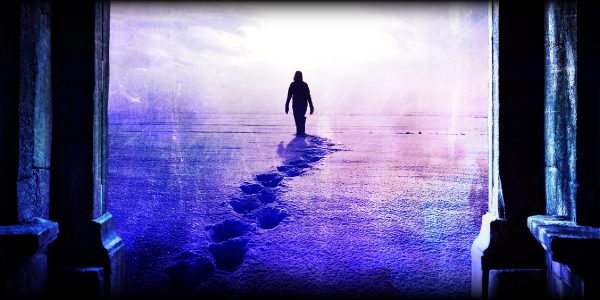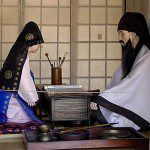This past weekend I had the opportunity to teach some workshops at a weekend retreat. It’s the annual retreat for an ADF (A Druid Fellowship) Grove in Michigan, and I’ve been working with some of their organizers for the past years to try and arrange to do some workshops with their group. The overall goal was to offer some skills and tools on leadership and community building as well as techniques of ecstatic and participatory ritual.
I was uncertain how the weekend would go. Well–I’m always uncertain when I travel to teach workshops someplace new, whether that’s a festival, a retreat, or a daylong or weekend intensive. I never know how it will play out until it happens. Maybe only a few people show up. Maybe there aren’t many people actually interested in the topic but they show up anyways, yet they don’t participate and instead are an energetic anchor dragging down the rest of the class. It’s hard enough to get people to participate.

No Pressure
In the case of this past weekend, one of my jobs was to demonstrate ecstatic, participatory ritual, while using a ritual format I’m unfamiliar with (the ADF “Core Order”)…with a group I didn’t know, and with a group I could reasonably expect to be somewhat resistant to the more ecstatic techniques.
For those not familiar with ADF-style ritual, first you might check out the overall flow of the Core Order. It looks rather a bit different from your typical Wiccanate ritual. And I’ll be blunt–ADF rituals have a reputation for being a bit dry; one of the things I like about the ADF tradition is their focus on scholarship, but that focus can lead to rituals that are heavy on the talky-talky. Not that the druids have a corner on that market; most of the public rituals I attend at Pagan Pride or other festivals are talky-talky no matter the tradition.
I ran into the expected resistance to the part of my workshop where we talked about the problems with scripted rituals. And, I get the reasons a lot of people cite for using scripts, but at the end of the day, it’s hard to get a group emotionally invested if everyone’s reading words off of a page. You lose all your body language, your voice is going down into the page, and you lose eye contact with your group. Worse, you lose connection with the group.
When I teach ritual, I’m not exactly asking people to do easy things. I’m asking people to go outside of their comfort zones to speak authentically, to emotionally engage their attendees. To risk physical movement, to risk eye contact, to risk singing together.
However…it works.
When we sing together, move together, dance together, when we sway to the drumbeat together, when we clap our hands or snap our fingers or stomp our feet in shared body rhythm…when we risk speaking authentically, something changes, something transforms. We risk intimacy, and we risk actually feeling an emotion together in the communal space of the ritual.
I’m asking people to step outside of their comfort zones by learning frame drumming techniques, or by learning to sing chants in order to lead them. I’m asking people to step outside of their comfort zones by speaking deeply and authentically about their own experiences and connection to the deities they are calling, their experiences with the three kindred, with the tree and the fire and the well sacred in the ADF tradition.
Yes–poetic liturgy can be evocative, but it so very much depends on the goal of the ritual. If you’re working with a deity people may be unfamiliar with, there needs to be an educational piece about that deity for the sake of the attendees. But, it’s so easy for the educational function to become a sermon, to go on and on and then you lose the energy, the vitality. You lose the group.
Striking that balance isn’t easy as a ritualist. There are a lot of balances to strike.
What’s the Intention?
For me, it always goes back to the intention of the ritual. It’s why I talk about designing rituals, not writing them. “Writing” a ritual implies it’s meant to be read. I use the term “designing” because a ritual is meant to be experienced.
In the afternoon session on ritual, we managed to pull together a number of important concepts of what the ritual should achieve and–together–we designed a ritual that would honor what those present found to be important about the Core Order, but that would also effect deeper personal transformative work and community building. And we were able to negotiate some smooth ways to weave in a number of ecstatic and participatory techniques.
I’ll need to do an entirely separate post just on the modified “Trance Hammer” technique I invented on the spot for this ritual. I’m calling it a Rolling Trance Hammer. In short, we were negotiating a way to honor the Fire, Tree, Well, the three Kindred (Ancestors, Nature Spirits, and Shining Ones) and the three deities we were working with in the ritual…but without the ritual requiring long bricks of text and without needing nine separate people to take ritual roles, or without three people having to triple up.
In the ritual, I engaged the group in toning (a rolling “om” or drone sound where they can add in harmonics or other vocalizations) and then other ritualists took turns speaking while I sang in extemporaneously about each of the different spirits/gods/etc. The first ritualist began speaking about the sacred fire while I sang words like, “Sacred fire, sacred flame,” until that person was finished, and then I’d roll into the next piece.
There were enough people anchoring the rolling tone that a few folks felt comfortable experimenting by adding harmonies and some counter-melodies, and that thickened the sound, made it more musically interesting and engaging. And engagement is the key, and that’s what I could feel throughout the whole ritual. People put their whole selves into it; I can tell the difference even through sound. In a ritual where people are hesitant, the sound is softer, quieter. People are less willing to experiment with harmonies, they stick just to the chant I’ve taught them.
Everything we did in the ritual had those evocative layers. The storytelling was three gods speaking their story. The trance journey was my voice leading the “story arc” with three other voices weaving in. In the trance journey we went out into the darkness to not only find our own magic, the magic that fuels the communal fire…but we also explored what we must release to be better servants of community. What must be released, or what shadows must be at least noticed and acknowledged.
People journeyed to multiple altars/shrines/stations to claim their magic…to step into service…to pull a rune of divination…and to gift their magic and their life force to the hearth fire, the heart fire, to the beating heart of the community.
Together we wove in a number of different participatory techniques, we wove in some extended chanting to hold space during the “journey” portion of the ritual, and we closed with an intensive and emotional energy raising to fulfill the core function of the ritual–to recharge the heart of the grove, to recharge the beating heart of that community.
What is the Heart?
This annual retreat isn’t just an opportunity to learn skills, it’s to reconnect as a tribe, a clan, a family. The bonds of friendship are just as important as the rituals being put on, just as important as learning skills in the workshops. In fact, it’s the opposite–people wanted to attend the workshops on boundaries and communication and community building and conflict resolution so that they could learn to be better friends and partners and community members.
All through the weekend, I had the pleasure of witnessing a close-knit group. So many of them obviously had long-term bonds of friendship, and they genuinely cared about one another. They cared enough to explore the concept of boundaries and consent, to explore different communication styles, in order to better work together and respect one another.
The ritual reflected that love. I often say that a group of 20-30 people is the most difficult group size if you’re trying to get people to participate in ritual. It’s too big for small group techniques, and it’s too small for large group techniques. In a group of 50 people I can usually count on enough singers to help anchor the chant, and I can count on that many bodies making people feel at least somewhat anonymous. That gets me in the door, so to speak, and people are willing to at least try to sing or move.
The exception that I always point out, though, is when you have a group with history, a group with the shared intimacy of friendship, and that’s what this group had.
It Doesn’t Always Work
I almost never know what I’m walking into when I travel to teach. There are plenty of times where I’ve taught workshops and I could tell the group wasn’t really engaged. And there are plenty of times where I’ve done my best to lead an ecstatic and participatory ritual to help the group get into a deeper place and have a transformative experience…and I know I missed the mark. Sure, it’s not necessarily anything I did wrong, it’s just that the deck isn’t always stacked in favor of an experience like that. I admit, though, that after the stress of traveling, and the energy expenditure of being an introvert walking into a group I don’t know, and then having a ritual that doesn’t quite get people into the deep places, I sometimes feel like a failures.
Maybe it’s more accurate to say that I feel that deep well of emotion and connection and I can’t quite touch it, I can’t quite dig down deep enough to get there, to help that group get to that sacred well and drink of those waters, and I want that for each person; it’s part of my spiritual path, my spiritual service.
Some nights, though, we get there.
Sometimes we dig down to that sacred well and we drink. Sometimes the very heart of the group itself opens the way to that well like a rose coming into blossom. Community is a beating heart, a pulsation. The sacred fire that heats the community needs fuel. We feed the fire and the fire feeds us. Community is a beating heart, it is breathing in, that breath flowing through our blood to feed our heart and our heart feeds us. Systole, diastole, pulsing, emptying and filling and emptying again. There is no community without us, there is no community without our service, without our breath and our song, without our blood and our tears and our sweat.
Once this group opened their lips to let out the song, the sound, the harmony…once that wave of sound began to rush and overlap wave over wave…once the layers took them into the deep within, the connection between them all became a palpable thing. There was the kind of depth and intimacy that isn’t possible to get in a large public ritual with people who don’t know each other. These people genuinely care about one another, and I could feel that in every heart beat, in the very sound they made together.
The heartbeat drew us together in the end as we sang, and we held the tangible symbol of the heart of the Grove to empower it and charge it for the coming year.
And, though I’m not a part of this group, I’m a guest, I felt held and included by that. It brought me to tears.
It can be hard to find the “magic” in ritual when you know so many ritual and trance techniques. I know the science of why ecstatic ritual works, but ritual can so often feel less “magical” because of that.
But here, during this weekend and this ritual, I remembered one of the secrets to that magic.
Love.
Genuine, actual, love.
Can’t fake it. Can’t plan for it. Can’t make it happen in a 90-minute public ritual slot. But I can make space for it. I can help make space to dig down into that sacred well, I can make space for people to actually connect to their deep selves, their own emotions…to risk connecting to the person next to them or across from them…to the divine.
There’s nothing like a ritual where there’s genuine connection, where there’s a palpable love between the community members.
Sacred Sound
We held this long, sustained toning at the end of the energy-raising chant and when the sound finally fell to silence I caught my breath and wept. You want to know the secret ingredient to potent ritual? Love. Want to know the secret to a healthy group? Love. No, love won’t fix all your problems and won’t get your group singing a chant, but with genuine respect and connection, with compassion and empathy, it’s possible to work through a lot of the logistics. More importantly, there’s a reason to bother.
I’ll remember that perfect moment for a long time. I go through dark nights where I wonder what I’m doing and why I’m doing it, and that moment with all our hands touching is the answer I seek. Why bother? That. That sound, that moment.
My thanks to my hosts this past weekend for reminding me why I do this and making me feel like a welcome family member. I’m already looking forward to working with the Cedarsong Grove again for Samhain; we’ll get a whole three days to focus on ritual facilitation and leading a Samhain rite together, and we’ll get to make that sacred sound again.

Patheos Pagan on Facebook.

the Agora on Facebook
Seeking the Grail is published on monthly on the third Monday. Subscribe via RSS or e-mail!
Please use the links to the right to keep on top of activities here on the Agora as well as across the entire Patheos Pagan channel.

















